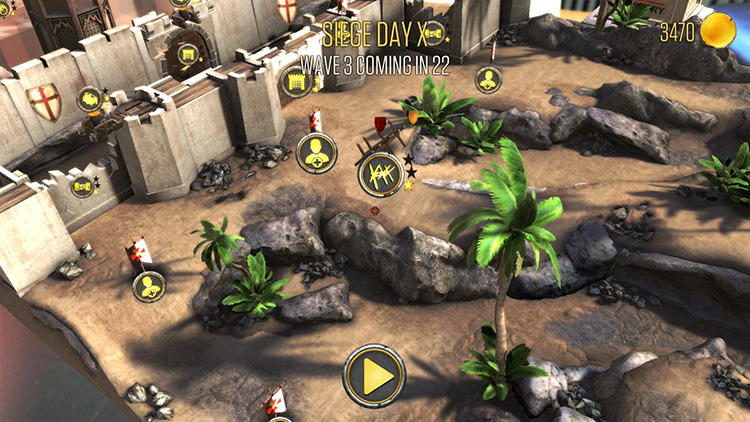Augmented reality (AR) marks a significant leap in gaming technology, introducing a fusion of digital and physical elements that enriches player interaction and engagement. This advancement isn't just about new games hitting the market; it signifies a shift in how games are developed and experienced. Every reputable аugmented reality game development company is at the forefront, crafting experiences that transcend traditional gaming boundaries.
By integrating digital objects with the real environment, AR games invite players into a layered reality where their physical surroundings interact with the game itself. This technology allows for games that respond to the player's environment, changing gameplay based on where they are and what's around them. For instance, a living room could turn into a puzzle room or a backyard into a battlefield, with the game dynamically adapting to physical spaces.
The role of AR in gaming is transformative, offering developers new creative avenues and players a more immersive and interactive experience. As technology progresses, the potential for AR in gaming expands, promising not just more realistic experiences but also more personal and engaging ones. This evolution reflects a broader trend towards more immersive digital experiences, signaling a future where games are not just played but experienced in harmony with our environments.
What Does AR Mean in Games?
Integrating augmented reality into games has significantly changed how we interact with gaming environments. After all, what is AR in gaming? Here, we move beyond the screen to incorporate our immediate surroundings into the gameplay. When exploring what AR means in gaming, it becomes evident that this technology allows digital elements to coexist with the real world, enhancing the gaming experience with an added layer of immersion and interactivity.
The concept of AR in gaming is pivotal for understanding how games are evolving. With AR, games are no longer confined to the dimensions of a screen. Instead, they spill out into the player's environment, turning physical spaces into components of the game itself. This shift is notable when considering how AR meaning in gaming has expanded. It's not just about overlaying graphics onto real-world views; it's about creating a seamless interaction between the player, the game, and their environment.
Addressing what AR stands for in games, we see a blend of reality and virtuality that challenges our perceptions of space and narrative within a gaming context. Games that utilize AR technology encourage players to move, observe, and interact with their surroundings in ways traditional video games cannot. This aspect of AR in gaming highlights a future where games could offer even more personalized and engaging experiences, leveraging the real-world context of each player.
So, what does AR stand for in gaming? Primarily, it showcases the versatility and potential of AR technology in creating diverse gaming experiences. From puzzle games that transform your living room into a mysterious ancient temple to action-packed adventures where your backyard becomes a battlefield, AR brings a new dimension to gaming that is both innovative and captivating.
Overall, AR's role in gaming represents a significant leap towards more immersive, interactive, and innovative gaming experiences. As technology progresses, the integration of AR in games is set to redefine the boundaries of gaming, offering players new worlds to explore within the comfort of their environment.
AR Gaming Through the Ages — A Tale of Evolution

Augmented reality in games has journeyed from humble beginnings to become a cornerstone of immersive game design. Initially, AR meaning in games was limited to simple overlays on physical objects, but today, it stands for a blend of digital and physical elements that create a seamless gaming experience.
The question "what does AR stand for in video games?" has evolved significantly over the years. In the early days, AR was a novel concept used in basic applications, allowing players to see digital images superimposed onto real-world backgrounds through their device screens. However, as technology advanced, so did the capabilities and complexity of AR in gaming. Developers began crafting experiences that were not just about seeing but interacting with digital elements as if they were part of the physical environment.
Immersive game design took a giant leap forward with the introduction of AR, transforming how stories are told and experienced. Games that utilize AR technology invite players to enter a game world overlaying their living spaces, parks, and cities. This shift made games more engaging and personal, as the environment around a player became an integral part of the game's narrative and mechanics.
The evolution of AR in gaming mirrors the growth of technology and its increasing integration into daily life. From basic overlays to complex interactions that require players to move, explore, and interact with both physical and digital elements, AR has expanded the definition of gaming. It allows for more creative freedom in game design and offers players experiences that were once impossible.
As AR continues to evolve, its impact on gaming promises to grow even more profound. New technologies and creative approaches to AR game design are poised further to blur the lines between the physical and the digital, creating even more immersive and engaging gaming experiences. The journey of AR in gaming is a testament to the endless possibilities that await at the intersection of technology and creativity.
The Great Debate: AR vs. VR in the Gaming Industry
Let's break down the core differences and discussions around augmented reality and virtual reality in the context of gaming through a comparative table:
| Feature/Aspect | AR in Gaming | VR in Gaming |
| Environment | Merges digital elements with the real-world setting. | Creates a fully digital environment for the player. |
| Hardware | Often uses smartphones, tablets, or AR glasses. | Requires headsets, sometimes with controllers. |
| Mobility | Allows players to move freely in their space. | Movement can be limited by cables or room setup. |
| Immersion | Enhances real-world surroundings with digital aspects. | Offers complete immersion in a digital world. |
| Accessibility | Generally more accessible and easy to adopt. | Can be expensive and require more setup. |
| Game Design | Must integrate real-world elements into gameplay. | Designers have full control over the environment. |
| Physical Interaction | Encourages physical movement in a real space. | Interaction occurs within the virtual space. |
| Social Aspect | Can be more social in public or shared spaces. | Often provides a solitary experience. |
| Examples | Pokémon GO, Harry Potter: Wizards Unite | Beat Saber, Half-Life: Alyx |

The debate between AR and VR in gaming often centers around the level of immersion versus accessibility and the physical versus fully digital experience. AR brings digital adventures into our physical world, encouraging exploration and movement in familiar environments. Conversely, VR transports players into entirely new worlds, offering a depth of immersion that's hard to replicate in any other medium. Each has its unique strengths, with AR excelling in integrating games into daily activities and social settings, while VR offers an escape into fully realized digital landscapes. The choice between AR and VR ultimately depends on what experience both developers and gamers are seeking: an enhancement of the real world or an escape from it.
The Mechanism Behind AR in Games
The core of AR in games hinges on seamlessly merging digital content with the real environment. At its foundation, augmented reality uses device cameras to capture the environment, and software interprets this data to place virtual objects in real-time. The process involves complex algorithms for object recognition, depth detection, and spatial awareness, ensuring that digital editions behave as if they were physically present.
Seamless integration. Augmented reality in games combines digital objects with the real environment using device cameras. This blend creates an immersive layer over the player's surroundings, making the gaming experience more engaging.
Environmental mapping. AR software processes data from the camera to place virtual objects in the environment. It uses algorithms to understand spatial relations, ensuring that digital elements appear to interact realistically with the physical space.
Object anchoring. Virtual objects in AR games are anchored to specific points in the physical world. This feature allows the objects to maintain their position relative to the user's environment, even as the user moves or the viewpoint changes.
User interaction. Players interact with the digital components through various inputs like touch, voice, and motion. This interaction is crucial for an immersive experience, allowing players to feel like they are directly influencing the game world.
Perspective tracking. The AR system adjusts the display based on the user's movement and orientation. This adjustment keeps the digital overlay consistent with the player's perspective, enhancing the realism of the interaction.
Location-based gameplay. Many AR games incorporate real-world locations into their gameplay using GPS data. This approach encourages players to explore their physical surroundings as part of the game, adding a unique layer of engagement.
All in all, the mechanism behind AR in gaming is a sophisticated blend of real-time image processing, environmental mapping, and interactive design. It transforms ordinary spaces into dynamic game environments, making every play session unique to the player's immediate surroundings.
Benefits of Using AR in Games

Augmented reality in gaming transforms ordinary spaces into interactive game environments, introducing benefits that enhance both the entertainment value and practical aspects of gaming.
Enhanced engagement. Players find AR games more engaging because they merge digital gameplay with the physical environment. This integration allows players to become part of the game, increasing immersion and making the gaming experience more vivid and interactive.
Innovative gameplay. AR introduces new mechanics and ways to play, transforming ordinary locations into integral parts of the game. It opens up possibilities for unique game designs that leverage the player's immediate surroundings, offering a fresh take on gaming.
Increased physical activity. Unlike traditional video games that often involve sitting in front of a screen, AR games encourage players to move around. By incorporating physical movement into gameplay, AR games promote health and wellness among players.
Social interaction. Many AR games are designed with social experiences in mind, encouraging players to collaborate or compete with others in real-world settings. This aspect fosters community and face-to-face interactions, enhancing the social benefits of gaming.
Educational opportunities. AR games can offer educational content in an engaging and interactive format. By overlaying information in the real world, players can learn about historical landmarks, wildlife, and more through gameplay, making learning fun and interactive.
Accessible technology. With the widespread availability of smartphones and tablets capable of running AR apps, these games are accessible to a broad audience. This accessibility means more people can enjoy the benefits of AR gaming without the need for expensive hardware.
By leveraging the capabilities of AR, games can transcend traditional gaming barriers, offering experiences that are not only entertaining but also beneficial in various aspects of life, from health to education and social interaction.
Challenges of Augmented Reality for Gaming
Exciting possibilities come with augmented reality in gaming, yet it also presents a set of significant challenges that need careful consideration.
- Hardware limitations. Many AR games require sophisticated hardware capable of processing complex visuals and interactions. This necessity can limit accessibility for players who do not own the latest devices, potentially narrowing the audience for these games.
- User safety. As AR games blend digital elements with the physical world, they often encourage movement in real-life environments. This aspect can pose safety risks, particularly in situations where players become so engrossed in the game that they neglect their surroundings.
- Development costs. Creating AR games involves high development costs due to the advanced technology and expertise required. These expenses can deter smaller studios from entering the AR gaming market, limiting the diversity and quantity of available games.
- Privacy concerns. AR games frequently use location data and camera access to function, raising privacy issues among users. Ensuring data security and user privacy remains a significant challenge for developers and publishers alike.
- Battery consumption. AR applications are known for their high battery usage, which can lead to shortened play sessions and a less satisfactory gaming experience. This limitation is a technical hurdle that developers must overcome to ensure longer engagement times.
- Content quality. Balancing the novelty of AR with the need for engaging content is challenging. Some games might rely too heavily on their AR feature at the expense of storytelling or gameplay depth, resulting in a gimmicky experience rather than a substantive game.
These challenges highlight the complexities of integrating AR into gaming, underscoring the need for ongoing innovation, safety considerations, and quality content to realize AR's potential in this dynamic industry fully.
Exploring the Diverse Types of AR Games
AR games are evolving rapidly, combining various types catering to different interests and activities. Each category introduces players to new ways of interacting with their environment through the lens of AR technology.
Location-based games draw players outside, turning neighborhoods and cities into game boards where physical presence in specific locations is key to progressing in the game. Pokémon GO is a prime example, encouraging exploration and interaction with real-world locations to catch virtual creatures.
Marker-based AR games use visual cues such as QR codes or specific images to trigger game events. By scanning these markers with a device, players can unlock digital content, ranging from 3D models to interactive scenes, right in their living room.
Projection-based AR games create interactive surfaces by projecting virtual images onto physical objects. This type of game offers a unique, hands-on experience, allowing players to touch and manipulate the projections as part of the gameplay. It's a whole new level of engagement with technology.
Superimposition-based AR replaces the original view with an augmented view, enhancing or completely changing the perception of an object. Furniture placement apps, which allow users to see how a piece of furniture would look in their room, employ this technique, though it's less common in traditional games.
Outlining AR games use boundary detection to play. They might outline paths or edges in the real world for racing games or puzzles, seamlessly blending physical elements with virtual challenges.
Face recognition AR transforms the player's face or another's into the game's interface, often used in social media filters but increasingly in games for character customization or interactive storytelling.
AR games break the mold of conventional gaming by offering experiences that merge the digital with the physical, creating immersive worlds that respond to the player's environment and actions in real time. As technology advances, the variety and depth of AR games continue to grow, promising even more innovative and engaging gameplay experiences.
Spotlight on the Examples of AR Gaming
Augmented reality has introduced a new dimension to gaming, blending the digital and physical in innovative ways. Here are several standout AR in gaming examples that showcase the diversity and potential of this technology.

Pokémon GO. This game became a cultural phenomenon by encouraging players to explore their neighborhoods to catch Pokémon. It utilizes location-based AR to bring the beloved creatures into the real world, merging physical movement with digital gameplay.

Ingress. Developed by the same company behind Pokémon GO, Ingress is a pioneering example of AR gaming that turns cities and landmarks into a competitive battlefield for two factions. Players capture territories by physically visiting locations, demonstrating AR's ability to transform the familiar into a playground.

Harry Potter: Wizards Unite. Building on the success of Pokémon GO, this game immerses players in the magical world of Harry Potter. Using location-based AR, players cast spells, discover artifacts, and encounter iconic characters and creatures from the series in their local surroundings.

Zombies, Run!. While not AR in the visual sense, this app blends storytelling with exercise, creating an immersive audio experience where players run to survive in a zombie apocalypse. It's a unique take on AR gaming, combining physical activity with engaging narratives.

AR Dragon. A pet simulation game where players can raise and interact with their virtual dragon in the real world. Using marker-based AR allows players to see their dragon come to life on their smartphones or tablets, demonstrating the potential for intimate and personal gaming experiences.

Knightfall™ AR. This game leverages AR to turn tabletops into battlefields, where players defend their city against an invading army. It showcases how projection-based AR can create interactive 3D environments on any flat surface.
These examples highlight AR's versatility in gaming, offering unique experiences that challenge the boundaries between digital content and the physical world. As AR technology evolves, the scope for immersive and interactive gameplay will only expand, promising future innovations in how we play and interact with games.
Game-Ace Presents Archy The Rabbit

Game-Ace's Archy the Rabbit reshapes expectations in gaming through augmented and mixed reality, blending virtual elements with the real world in an educational and fun experience. Ideal for all ages, it seamlessly introduces players to futuristic gaming. Discover the future of interactive play with Archy the Rabbit — dive in now.
Foreseeing AR's Next Level in the GameDev Field
Within the game production industry, augmented reality technology is developing quickly and expanding the possibilities for gameplay. As it becomes more advanced, the potential of AR technology in game production is growing, opening up new opportunities for gamers and creators. An important area of development is the improvement of spatial computing.
In augmented reality games, players' ability to see and understand the physical environment around them will likely improve. Future augmented reality titles should provide even more realistic experiences by precisely mapping and integrating with players' surroundings. This will enable games to turn any area into a dynamic gaming field.
The advancement of AR wearables is another innovation to look forward to. Even if they are revolutionary, today's technologies frequently have uncomfortable and narrow fields of vision. With the anticipated reduced weight, improved comfort, and wider viewing angle of the upcoming generation of AR glasses and headsets, longer gaming sessions will be more practical and pleasurable.
AR's potential to change social interaction is also imminent. Anticipated augmented reality games will improve multiplayer gameplay by enabling players to engage with one another's game aspects in real-time, even while they are geographically separated. This might completely change how people play online multiplayer games by incorporating a physical element into virtual interactions. Furthermore, the combination of augmented reality and artificial intelligence (AI) will make games that are responsive to each player's choices and activities possible. Imagine playing games that change as you do, presenting you with unique challenges and storylines.
Improvements are also anticipated in terms of development simplicity and accessibility. Thanks to the development of more user-friendly tools and platforms for AR game production, more creators will be able to realize their ideas. Due to the democratization of AR game production, there will probably be an increase in creative and varied content. AR in game production has the potential to provide experiences that are more customized, immersive, and engaging than ever before. As we look to the future, AR gaming has pretty much to offer, which ultimately has the potential to upturn interactive entertainment.
Step on the side of winners — join Game-Ace in AR gamedev.
Game-Ace Crafting Your AR Gaming
In conclusion, the future of gaming, especially with the integration of AR, paints a landscape brimming with potential. As we've explored the various facets of AR in gaming — from its immersive experiences to the challenges and innovations on the horizon — it's clear that AR is not just a fleeting trend but a substantial evolution in how games are played and experienced. It’s here that Game-Ace positions itself as a real player.
As a custom game development company, our commitment to leveraging AR technologies allows us to create games that are not only engaging but also pioneering. We are dedicated to transforming imaginative ideas into tangible experiences that resonate with users across the globe. If you are looking to explore the vast possibilities of AR in gaming, consider reaching out to us. In partnership, we can craft experiences that set new standards in the gaming industry.
 How Much Does It Cost to Make a Video Game in Real-World Conditions?
How Much Does It Cost to Make a Video Game in Real-World Conditions?  Metaverse Gaming 2024: The Next GameDev Milestone or Another Soap Bubble?
Metaverse Gaming 2024: The Next GameDev Milestone or Another Soap Bubble?  Mobile Gaming Trends 2024: Genres, Technologies, Demographics
Mobile Gaming Trends 2024: Genres, Technologies, Demographics  What is The Key to Immersive Game Design?
What is The Key to Immersive Game Design? 


























